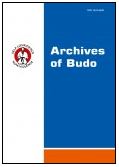2017, Volume 13
The spine mobility of karate master class contestants
Arletta Hawrylak1, Krystyna Chromik2, Katarzyna Barczyk- Pawelec1, Ewa Demczuk-Włodarczyk1
1Faculty of Physiotherapy, Department of Physiotherapy, University School of Physical Education in Wroclaw, Wrocław, Poland
2Faculty of Sport Science, Department of Physical Anthropology, University School of Physical Education in Wroclaw, Wrocław, Poland
Author for correspondence: Krystyna Chromik; Faculty of Sport Science, Department of Physical Anthropology, University School of Physical Education in Wroclaw, Wrocław, Poland; email: krystynachromik[at]gmail.com
Full text
Abstract
Background and Study Aim: Karate is one of the most popular martial arts practised all over the world. Karate training puts considerable strain on peripheral joints, and rotational movements of the spine may considerably influence its mobility. The aim of this paper is the knowledge about the mobility of particular sections of the spine of karate national team contestants compared to people who do not practise any sports disciplines.
Material and Methods: Thirty-eight men (aged 26.8 ±4.67).19 kumite contestants and 19 control group. The assessment of the spine mobility in sagittal plane, frontal plane, and transverse plane was performed with the use of a universal Saunders inclinometer according to generally accepted principles
Results: Ranges of the spine mobility oscillated within assumed standards in both groups. Statistically significant higher values of the spine mobility range were obtained by those who trained karate and referred to the range of the lumbar spine flexion towards a dominant limb and a non-dominant limb as well as a movement of the thoracic section of the spine towards a non-dominant limb (p≤0.05).
Conclusions: Long-term karate training results in an increased mobility of the spine in training individuals compared to their non-training peers. In karate practitioners, lower values in relation to the standard were observed only within the range of extension of the lumbar section and flexion of the cervical and lumbar spine. This indicates the need to introduce specialist exercises to the training to compensate for the deficiencies of the spine mobility.
Key words: martial arts, kumite, injuries, combat sports, Saunders inclinometer




